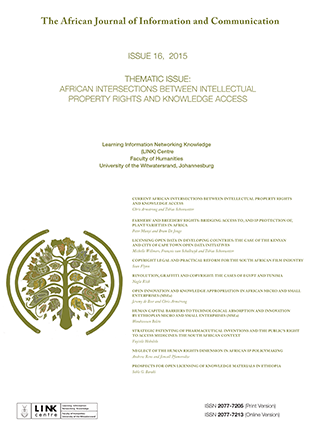Human Capital Barriers to Technological Absorption and Innovation by Ethiopia’s Micro and Small Enterprises (MSEs)
DOI:
https://doi.org/10.23962/10539/19316Keywords:
Ethiopia, micro and small enterprises (MSEs), innovation, patents, patent information, public domain, intellectualAbstract
Ethiopia's private sector is dominated by micro and small enterprises (MSEs), many of them operating informally. Accordingly, a key challenge for the country's science, technology and innovation (STI) policymakers is finding ways to ensure that these small businesses absorb external technological innovations in order to enhance their performance and allow for follow-on innovations. This policy objective has an access to knowledge (A2K) dimension, because Ethiopia's STI policies and strategies stress the need for improved MSE access to public domain patent information as a means to improving technological absorption. However, research by the Ethiopian Intellectual Property Office (EIPO) has found that despite the efforts of the Ethiopian government to foster small-enterprise absorption of public domain technological information contained in patent documents, MSE take-up of such technology tends to be poor (Belete, 2013). In this piece, the author, former EIPO Director of Intellectual Property Policy and Planning, argues that the government’s emphasis needs to be on building human capital in MSEs, in order to improve their capacity to absorb patent information. This argument draws on literature linking technological absorption capacity to human capital levels, along with findings from an Ethiopian government survey of 3,000 MSEs (MUDC, 2013). The author recommends improved MSE collaboration with intermediary organisations such as the country’s Technical and Vocational Education and Training (TVET) institutions and industry development institutes.
References
Arnold, E., & Bell, M. (2001). Some new ideas about research and development. In Partnerships at the leading edge: A Danish vision for knowledge, research and development. Report of the Commission on Development-Related Research, funded by DANIDA, Ministry of Foreign Affairs.
Copenhagen.Belete, W. (2013). The making of Ethiopia’s innovation system. Discussion Paper Number 2. African Technology Policy Studies Network (ATPS)-Ethiopia Chapter. Addis Ababa.
Carter, A.P. (1989). Knowhow trading as economic exchange. Research Policy, 18(3), 155-163. https://doi.org/10.1016/0048-7333(89)90003-6
Central Statistical Agency (CSA). (2014). 2014 urban employment unemployment survey statistical report. Addis Ababa.
Chesbrough, H. (2003). Open innovation: The new imperative for creating and profiting from technology. Boston, MA: Harvard Business School Press.
Cohen, W.M., & Levinthal, D.A. (1990). Absorptive capacity: A new perspective on learning and innovation. Administrative Science Quarterly, 35(1), 128-152. https://doi.org/10.2307/2393553
European Commission (EC) & European Patent Office (EPO). (2007). Why researchers should care about patents. Retrieved from http://ec.europa.eu/invest-in-research/pdf/download_en/patents_for_researchers.pdf
Federal Democratic Republic of Ethiopia (FDRE). (1996). Licensing and Supervision of Micro Financing Institutions Proclamation No. 40/1996. Addis Ababa.
FDRE. (1997). Micro and small enterprise development strategy. Addis Ababa.
FDRE. (2002). Industrial development strategy. Addis Ababa (in Amharic).
FDRE. (2003). Ethiopian Intellectual Property Office Establishment Proclamation of 2003, Proc. No. 320/2003. Addis Ababa.
FDRE. (2011). Micro and small enterprise development strategy: Provision framework and methods of implementation. Addis Ababa.
FDRE. (2012). Science, Technology and Innovation (STI) Policy of Ethiopia. Addis Ababa.
Giuliani, E., & Bell, M. (2004). When micro shapes the meso: Learning networks in a Chilean wine cluster. SPRU Electronic Working Paper Series, Paper no. 115. Retrieved from https://www.sussex.ac.uk/webteam/gateway/file.php?name=sewp115.pdf&site=25
Imperial Ethiopian Government (IEG). (1966). Investment Proclamation 242/1966. Addis Ababa.
Keller, W. (2004). International technology diffusion. Journal of Economic Literature, XLII, 752-782. https://doi.org/10.1257/0022051042177685
Kim, L. (1997). Imitation to innovation: The dynamics of Korea’s technological learning. Boston: Harvard Business School Press.
Lall, S. (1992). Technological capabilities and industrialization. World Development, 2(2), 165-86. https://doi.org/10.1016/0305-750X(92)90097-F
Ministry of Education (MoE). (2008). National technical and vocational education and training (TVET) strategy. Addis Ababa.
Ministry of Finance and Economic Development (MoFED). (2010). Growth and transformation plan (2010/11–2014/15): Vol. I: Main text. Addis Ababa.
Ministry of Urban Development and Construction (MUDC). (2013). Survey on micro and small enterprises (MSEs) in selected major cities of Ethiopia. Addis Ababa. Retrieved from http://www.mwud.gov.et/c/document_library/get_file?uuid=28a0fa5f-8689-4828-9244-7187413fb248&groupId=10136
Narula, R. (2003). Understanding absorptive capacities in an “innovation systems” context: Consequences for economic and employment growth. DRUID Working Paper No 04-02. Danish Research Institute for Industrial Dynamics. Retrieved from http://www3.druid.dk/wp/20040002.pdf
PRH: Finnish Patent and Registration Office. (2014).Databases. Retrieved from http://www.prh.fi/en/patentit/tietokannat.html
UN Conference on Trade and Development (UNCTAD). (2007).The least developed countries report 2007: Knowledge, technological learning and innovation for development. Retrieved from http://unctad.org/en/Docs/ldc2007_en.pdf
Vanhaverbeke, W.C.M., & Van de Vrande, V. (2007). Connecting absorptive capacity and open innovation. In J. Fagerberg, D. Mowery, & B. Verspagen (Eds.), Proceedings of the CAS workshop on innovation in firms, October 30-November 1, 2007. Oslo: Centre for Advanced Study. https://doi.org/10.2139/ssrn.1091265
Vinding, A.L. (2006). Absorptive capacity and innovative performance: A human capital approach. Economics of Innovation and New Technology, 15(4/5), 507-517. https://doi.org/10.1080/10438590500513057
World Intellectual Property Organisation (WIPO). (2004). WIPOintellectual property handbook. Retrieved from http://www.wipo.int/edocs/pubdocs/en/intproperty/489/wipo_pub_489.pdf
WIPO. (2005). Exchanging value: Negotiating technology licensing agreements. Retrieved from http://www.wipo.int/export/sites/www/sme/en/documents/pdf/technology_licensing.pdf
Zahra, S.A., & George, G. (2002). Absorptive capacity: A review, reconceptualization, and extension. Academy of Management Review, 27(2), 185-203. https://doi.org/10.2307/4134351
Downloads
Published
Issue
Section
License
Copyright (c) 2015 https://creativecommons.org/licenses/by/4.0

This work is licensed under a Creative Commons Attribution 4.0 International License.
How to Cite
- Abstract 265
- pdf 101


.png)